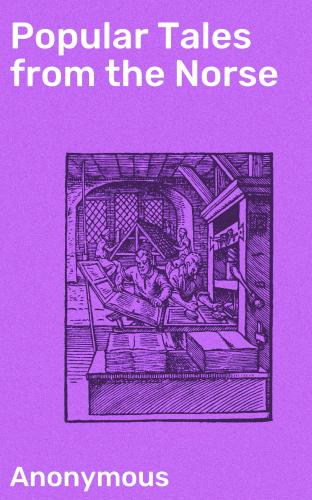THE LITTLE CHILD AND THE PUMPKIN TREE
THE LION, THE GOAT, AND THE BABOON
INTRODUCTION
ORIGIN DIFFUSION NORSE MYTHOLOGY NORSE POPULAR TALES CONCLUSION
TALES
I TRUE AND UNTRUE II WHY THE SEA IS SALT III THE OLD DAME AND HER HEN IV EAST O' THE SUN, AND WEST O' THE MOON V BOOTS WHO ATE A MATCH WITH THE TROLL VI HACON GRIZZLEBEARD VII BOOTS WHO MADE THE PRINCESS SAY, 'THAT'S A STORY' VIII THE TWELVE WILD DUCKS IX THE GIANT WHO HAD NO HEART IN HIS BODY X THE FOX AS HERDSMAN XI THE MASTERMAID XII THE CAT ON THE DOVREFELL XIII PRINCESS ON THE GLASS HILL XIV THE COCK AND HEN XV HOW ONE WENT OUT TO WOO XVI THE MASTER-SMITH XVII THE TWO STEP-SISTERS XVIII BUTTERCUP XIX TAMING THE SHREW XX SHORTSHANKS XXI GUDBRAND ON THE HILL-SIDE XXII THE BLUE BELT XXIII WHY THE BEAR IS STUMPY-TAILED XXIV NOT A PIN TO CHOOSE BETWEEN THEM XXV ONE'S OWN CHILDREN ARE ALWAYS PRETTIEST XXVI THE THREE PRINCESSES OF WHITELAND XXVII THE LASSIE AND HER GODMOTHER XXVIII THE THREE AUNTS XXIX THE COCK, THE CUCKOO, AND THE BLACK-COCK XXX RICH PETER THE PEDLAR XXXI GERTRUDE'S BIRD XXXII BOOTS AND THE TROLL XXXIII GOOSEY GRIZZEL XXXIV THE LAD WHO WENT TO THE NORTH WIND XXXV THE MASTER THIEF XXXVI THE BEST WISH XXXVII THE THREE BILLY-GOATS GRUFF XXXVIII WELL DONE AND ILL PAID XXXIX THE HUSBAND WHO WAS TO MIND THE HOUSE XL DAPPLEGRIM XLI FARMER WEATHERSKY XLII LORD PETER XLIII THE SEVEN FOALS XLIV THE WIDOW'S SON XLV BUSHY BRIDE XLVI BOOTS AND HIS BROTHERS XLVII BIG PETER AND LITTLE PETER XLVIII TATTERHOOD XLIX THE COCK AND HEN THAT WENT TO THE DOVREFELL L KATIE WOODENCLOAK LI THUMBIKIN LII DOLL I' THE GRASS LIII THE LAD AND THE DELL LIV THE COCK AND HEN A-NUTTING LV THE BIG BIRD DAN LVI SORIA MORIA CASTLE LVII BRUIN AND REYNARD LVIII TOM TOTHERHOUSE LIX LITTLE ANNIE THE GOOSE GIRL
APPENDIX
INTRODUCTION TO APPENDIX
1. WHY THE JACK SPANIARD'S WAIST IS SMALL 2. ANANZI AND THE LION 3. ANANZI AND QUANQUA 4. THE EAR OF CORN AND THE TWELVE MEN 5. THE KING AND THE ANT'S TREE 6. THE LITTLE CHILD AND THE PUMPKIN TREE 7. THE BROTHER AND HIS SISTERS 8. THE GIRL AND THE FISH 9. THE LION, THE GOAT, AND THE BABOON 10. ANANZI AND BABOON 11. THE MAN AND THE DOUKANA TREE 12. NANCY FAIRY 13. THE DANCING GANG
FOOTNOTES TO INTRODUCTION
INTRODUCTION
ORIGIN
The most careless reader can hardly fail to see that many of the Tales in this volume have the same groundwork as those with which he has been familiar from his earliest youth. They are Nursery Tales, in fact, of the days when there were tales in nurseries—old wives' fables, which have faded away before the light of gas and the power of steam. It is long, indeed, since English nurses told these tales to English children by force of memory and word of mouth. In a written shape, we have long had some of them, at least, in English versions of the Contes de ma Mère l' Oye of Perrault, and the Contes de Fées of Madame D'Aulnoy; those tight-laced, high- heeled tales of the 'teacup times' of Louis XIV and his successors, in which the popular tale appears to as much disadvantage as an artless country girl in the stifling atmosphere of a London theatre. From these foreign sources, after the voice of the English reciter was hushed—and it was hushed in England more than a century ago—our great-grandmothers learnt to tell of Cinderella and Beauty and the Beast, of Little Red Riding-hood and Blue Beard, mingled together in the Cabinet des Fées with Sinbad the Sailor and Aladdin's wondrous lamp; for that was an uncritical age, and its spirit breathed hot and cold, east and west, from all quarters of the globe at once, confusing the traditions and tales of all times and countries into one incongruous mass of fable, as much tangled and knotted as that famous pound of flax which the lassie in one of these Tales is expected to spin into an even wool within four-and-twenty hours. No poverty of invention or want of power on the part of translators could entirely destroy the innate beauty of those popular traditions; but here, in England at least, they had almost dwindled out, or at any rate had been lost sight of as home-growths. We had learnt to buy our own children back, disguised in foreign garb; and as for their being anything more than the mere pastime of an idle hour—as to their having any history or science of their own—such an absurdity was never once thought of. It had, indeed, been remarked, even in the eighteenth century—that dreary time of indifference and doubt—that some of the popular traditions of the nations north of the Alps contained striking resemblances and parallels to stories in the classical mythology. But those were the days when Greek and Latin lorded it over the other languages of the earth; and when any such resemblance or analogy was observed, it was commonly supposed that that base-born slave, the vulgar tongue, had dared to make a clumsy copy of something peculiarly belonging to the twin tyrants who ruled all the dialects of the world with a pedant's rod.
At last, just at the close of that great war which Western
